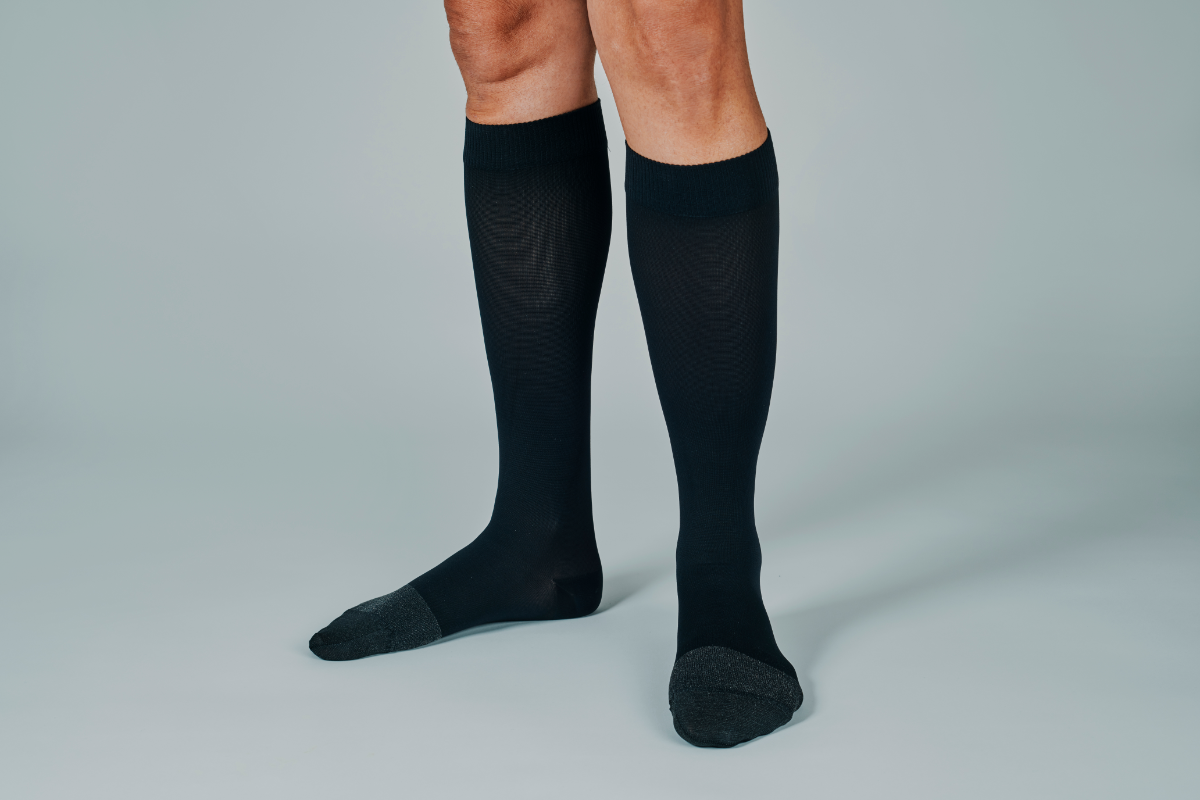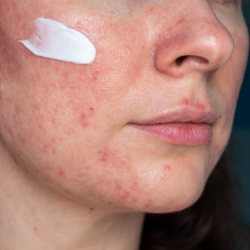Varicose eczema, often referred to by the medical terms stasis dermatitis or stasis eczema, is a chronic inflammation of the skin. Typically found on the lower limbs, this dermatological condition generally occurs in response to chronic venous insufficiency. This causes an increase in pressure in the veins of the legs, impeding venous return and leading to characteristic skin symptoms.
In the information age, where many treatment solutions are available online, it is crucial to separate the true from the false and provide scientifically proven data. With this in mind, the aim of this article is to provide a comprehensive and up-to-date overview of the different management strategies for varicose eczema, with particular emphasis on case studies and recent scientific evidence.
What is varicose eczema?
Varicose eczema, also known as stasis dermatitis, is a specific skin condition associated with disorders of venous circulation in the lower limbs. This dermatological condition is closely linked to chronic venous insufficiency, a condition in which the veins have difficulty carrying blood to the heart, resulting in blood stagnation and increased pressure in the vessels of the legs. The skin, subjected to this constant pressure, reacts with inflammation that manifests itself in the form of eczema.
According to clinical data, varicose eczema mainly affects older adults, with a higher prevalence observed in people with a history of varicose veins or thrombophlebitis. Scientific studies, particularly those published in specialist dermatological journals, highlight the link between chronic inflammation of the veins and the development of this form of eczema. This research highlights the importance of treating venous insufficiency to prevent or treat stasis dermatitis.
Clinically, varicose eczema is characterised by red, hot skin, often accompanied by intense itching,skin thickening and sometimes oozing. It is usually seen around the ankles or on the lower legs and can be diagnosed by a healthcare professional through a physical examination and, if necessary, using additional tests such as Doppler ultrasound to assess venous circulation.
Early identification of symptoms is essential to avoid complications such as varicose ulcers, which are an advanced form of the disease. The treatment of varicose eczema is based on several pillars: improving blood circulation, appropriate dermatological care and controlling inflammation and itching.
What are the symptoms of varicose eczema?
Varicose eczema, often referred to in medical circles as stasis dermatitis, manifests itself through a specific range of symptoms. These clinical signs are essential to identify for early diagnosis and treatment. The most frequently reported symptoms include:
- Reddening of the skin: Areas of reddened skin, particularly around the ankles and calves, may indicate inflammation linked to venous stasis.
- Itching: This is often the first symptom noticed by patients. This itching, sometimes intense, is caused by irritation and inflammation of the skin.
- Dry, flaky skin: The skin may become dry and flaky, resembling small scales.
- Thickening of the skin: Over time, the skin may thicken and harden, a phenomenon known as lipodermatosclerosis.
- Discharge or oozing: In severe cases, the skin may ooze and form scabs.
- Pain: Pain may accompany the other symptoms, especially during movement.
- Varicose veins: Visibly dilated and tortuous veins are often associated with varicose eczema.
- Change in skin colour: A brown pigmentation or reddish discolouration may be observed, resulting from blood flowing out of the affected veins and into the skin.
It is important for patients to recognise these symptoms and consult a doctor or dermatologist promptly, as varicose eczema can lead to more serious complications, such as venous ulcers, if the condition is not treated properly.
What causes varicose eczema?
Varicose eczema, commonly associated with stasis dermatitis, is caused by an abnormality in the venous system of the lower limbs. Let’s start by understanding the venous mechanism: the veins in the legs are equipped with valves whose function is to encourage the return of blood to the heart. With age or because of specific risk factors, these valves can lose their effectiveness. This valve insufficiency can lead to a leakage of fluid and blood, which then accumulates in the lower leg, creating a condition known as venous insufficiency.
Over time, if left untreated, venous insufficiency can develop into venous stasis dermatitis. In this condition, the skin becomes irritated and begins to break down in response to the accumulation of subcutaneous fluid.
Several risk factors have been identified, including:
- Female gender: Women are more likely to develop this condition, particularly due to hormonal fluctuations associated with pregnancy and the menopause.
- Pregnancy: Pregnancy puts extra pressure on the leg veins and can contribute to venous insufficiency.
- Obesity: Being overweight increases the pressure in the veins of the legs, aggravating the risk of venous insufficiency.
- Advanced age: Over time, venous valves can deteriorate naturally.
- A history of deep vein thrombosis (DVT): DVT can damage vein valves and lead to venous insufficiency.
- A sedentary lifestyle: Lack of movement can prevent good blood circulation in the legs.
- Congestive heart failure: This condition can also contribute to venous insufficiency.
- A history of venous surgery or deep leg injury: Any operation or trauma can alter venous function.
- Kidney disease: This can interfere with the balance of fluids in the body and influence venous health.
- Uncontrolled chronic hypertension: This can weaken venous valves and lead to stasis dermatitis.
How can stasis dermatitis be prevented?
Stasis dermatitis is a chronic skin condition, but with a proper treatment plan and rigorous self-care, it can be controlled and prevented from worsening. Here are some practices recommended by dermatologists (1) to prevent stasis dermatitis:
- Elevate your legs above heart level: it is advisable to do this several times during the day, ideally for 15 minutes every two hours and during sleep, using cushions for example. This position encourages blood circulation.
- Take active breaks: if your job requires you to sit or stand for long periods, take a break every hour and walk briskly for 10 minutes to stimulate circulation.
- Get regular exercise: exercise can improve your circulation and strengthen your calf muscles. Walking is particularly beneficial. Don’t hesitate to ask your dermatologist for advice on adapting the intensity and frequency of exercise to your condition.
- Wear loose-fitting cotton clothing: tight fabrics such as polyester or wool can irritate stasis dermatitis skin and trigger an exacerbation of the condition.
- Use compression garments if recommended: they can improve circulation in the legs, prevent ulcers and reduce the risk of recurrence. If using compression garments is difficult or uncomfortable for you, talk to your dermatologist, who will be able to give you tips or refer you to a physical therapy.
- Avoid injuring or irritating the affected area: skin affected by stasis dermatitis is very sensitive. Avoid contact with potential irritants such as animal hair, cleaning chemicals and perfumes, and opt for fragrance-free skincare products.
- Moisturise your skin regularly: using a fragrance-free moisturiser or petroleum jelly on still damp skin after bathing can prevent skin dryness and irritation.
- Take care when bathing: use gentle, fragrance-free cleansers and avoid rough towels or sponges, which can irritate the skin.
- Maintain a healthy weight: this can reduce swelling and improve your overall health.
- Stay sufficiently hydrated: drinking around 8 glasses of water a day can improve circulation and reduce swelling.
- Limit your salt intake: excessive salt consumption can affect blood circulation.
- Keep your appointments with your dermatologist : managing stasis dermatitis is an ongoing process that can take time to find the most effective methods of treatment and prevention.
How is varicose eczema treated?
Treating varicose eczema requires a holistic approach that takes into account both symptom management and treatment of the underlying cause, i.e. chronic venous insufficiency. Here are the key steps and advice for effective treatment:
- Use of compression stockings: Compression stockings are often the first treatment recommended to reduce swelling and improve blood circulation. They should be worn as prescribed by a healthcare professional.
- Skin care: Good hygiene and moisturising the skin with emollient creams or steroid-based ointments can help reduce inflammation and prevent infection.
- Controlling itching and inflammation: Topical corticosteroid creams can be prescribed to control these symptoms. For severe itching, oral antihistamines may be recommended.
- Elevating the legs: Elevating the legs several times a day helps to reduce oedema and improve venous return.
- Physical exercise: Physical activity, particularly walking, can promote circulation and healthy veins.
- Hydration and nutrition: Adequate hydration and a balanced diet low in salt can help reduce fluid retention.
- Medical treatments: Procedures such as sclerotherapy, laser interventions or surgery may be considered to treat underlying varicose veins.
- Risk factor management: It is important to manage risk factors such as obesity, a sedentary lifestyle and high blood pressure to prevent venous insufficiency from worsening.
- Regular monitoring: Regular dermatological monitoring allows treatment to be adjusted if necessary and the progress of the disease to be monitored.
- Patient education: Patients need to be informed about their condition so that they can recognise the signs of worsening and the steps to take in the event of complications, such as infection.
It is essential to consult a healthcare professional to obtain an accurate diagnosis and a personalised treatment plan.Informed self-management and cooperation with healthcare professionals are crucial aspects of treating varicose eczema.
How do you look after your skin in the event of stasis dermatitis?
Taking care of your skin when you have stasis derm atitis is essential to prevent complications and improve quality of life. Here are some recommendations based on proven practices and clinical studies:
- Moisturising the skin: Use fragrance-free moisturisers such as Vaseline or emollient creams to maintain skin hydration. Apply to slightly damp skin, ideally after a bath or shower, to lock moisture into the skin.
- Gentle cleansing: Opt for gentle, soap-free cleansers. Harsh cleansers can dry out the skin and make itching worse.
- Protection against injury: Avoid cuts and bruises by wearing protective clothing and being vigilant during everyday activities. Skin affected by stasis dermatitis is fragile and susceptible to infection.
- Managing itching: To reduce itching, apply cold compresses and avoid scratching the affected areas. The use of calamine creams or antihistamines may be beneficial, depending on the advice of a healthcare professional.
- Use of appropriate clothing: Choose soft cotton clothing and avoid rough or tight fabrics that can rub against the skin and cause irritation.
- Environmental control: Keep your environment cool and well-humidified to prevent the skin from drying out.
- Compression: Medical compression garments, such as compression stockings or socks, may be prescribed to promote blood circulation. Make sure they are properly fitted by a professional.
- Physical activity: Regular exercise, especially walking, promotes blood circulation and can help prevent the symptoms of stasis dermatitis.
- Avoid irritants: Eliminate or minimise exposure to potential irritants such as perfumes, dyes and certain cleaning products.
- Nutrition and hydration: Good nutrition and adequate hydration are crucial. Water helps keep the skin hydrated from the inside out, while a low-salt diet can reduce swelling.
- Medical consultation: Regular follow-up with a dermatologist or specialist in phlebology is necessary to adapt care and prevent complications.
FAQ
Q : What is varicose eczema? R : Varicose eczema, also known as stasis dermatitis, is a skin condition linked to poor blood circulation, often in the legs. It causes itching, inflammation and changes in skin colour.
Q : Who is most likely to develop varicose eczema?
A : Middle-aged and older people, particularly women, are more prone to this condition. Risk factors include obesity, pregnancy, a sedentary lifestyle, heart failure, a history of deep vein thrombosis (DVT) or leg vein surgery.
Q : What are the symptoms of varicose eczema?
A: Symptoms include itching, redness, dryness, flaking of the skin and sometimes pain. If left untreated, oozing, crusting and ulceration can occur.
Q : How is varicose eczema diagnosed?
A : The diagnosis is usually made by a thorough physical examination and may be supplemented by tests such as a venous Doppler to assess blood circulation in the legs.
Q : What are the possible complications of varicose eczema?
A : Without appropriate treatment, it can lead to skin infections, venous ulcers and chronic pain.
Q : How is varicose eczema treated?
A: Treatment includes measures to improve circulation, such as elevating the legs and wearing compression stockings, as well as skin care with moisturisers and topical steroids to reduce inflammation.
Q : Can varicose eczema be prevented?
A : Yes, by maintaining a healthy lifestyle to avoid risk factors such as obesity and by managing any underlying conditions that affect blood circulation.
Q : Can varicose eczema be completely cured?
A : Although it can be successfully managed, varicose eczema is often a chronic condition. Regular monitoring and ongoing treatment are usually required.
Q : Is exercise recommended for people with varicose eczema?
A : Yes, regular exercise, especially walking, can help improve circulation and reduce symptoms.
Q : What should I do if I think I have varicose eczema?
A: Consult a healthcare professional, such as a dermatologist or phlebologist, for a diagnosis and appropriate treatment plan.
Source:
(1) https://www.aad.org/public/diseases/eczema/types/stasis-dermatitis/self-care
https://www.aad.org/public/diseases/eczema/types/stasis-dermatitis
https://jamanetwork.com/journals/jamadermatology/fullarticle/2785017
https://pubmed.ncbi.nlm.nih.gov/27179983/
https://pubmed.ncbi.nlm.nih.gov/32205126/







